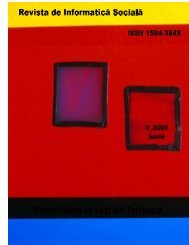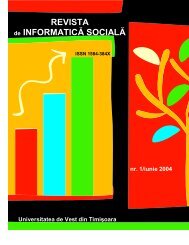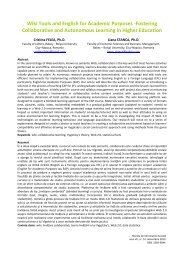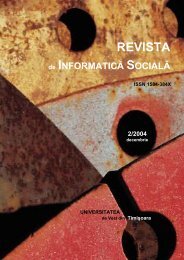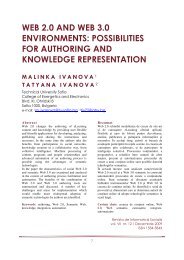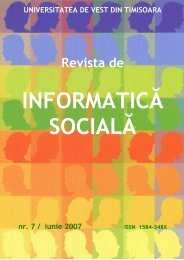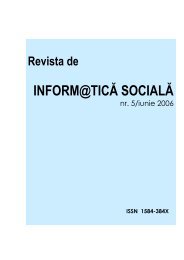No 13 - Journal of Social Informatics / Revista de Informatica Sociala
No 13 - Journal of Social Informatics / Revista de Informatica Sociala
No 13 - Journal of Social Informatics / Revista de Informatica Sociala
You also want an ePaper? Increase the reach of your titles
YUMPU automatically turns print PDFs into web optimized ePapers that Google loves.
In such cases, conventional "top down" information as it is produced by journals is or<br />
institutional PR staff is outperformed and marginalized by "bottom up" communications stemming<br />
from individuals who make their own observations and thoughts and who are personally affected<br />
and involved. In comparison to traditional media reporting, a more encompassing and unbiased<br />
overall picture is likely to emerge, because data originate from many different sources - for<br />
individuals and groups located in remote rural places that would never be covered by conventional<br />
mass media reports.<br />
For journalists, therefore, Twitter has the capacity to become one <strong>of</strong> the very primary news<br />
sources that have to be watched permanently in or<strong>de</strong>r to remain in real-time contact with unfolding<br />
events. This is particularly important in cases <strong>of</strong> events that happen unpredictably and in remote<br />
places where no journalists, but only lay users are available for first-hand reporting.<br />
<strong>Journal</strong>ists reporting about ongoing events will be pressed to assume themselves a new role<br />
as “tweeters”. They may earn money by people who become their “followers”: paying fees for<br />
getting the reporters’ short messages just at the time they are watching the unfolding event<br />
(National Press Club 2008). Evi<strong>de</strong>ntly, such journalists are likely to be bombar<strong>de</strong>d with inquiring<br />
requests: so that users become empowered to <strong>de</strong>termine in <strong>de</strong>tail their ongoing work (e.g. the kind<br />
<strong>of</strong> data they are collecting and the kind <strong>of</strong> subjects they will chose for interviewing).<br />
The same capacity <strong>of</strong> instant molecular messaging to subvert formal structures by<br />
un<strong>de</strong>rmining conventional top-down communication could potentially also well be realized within<br />
specific institutions: e. g. scientific congresses or schools .<br />
For instance, Twitter may be used by stu<strong>de</strong>nts for feeding back their immediate reactions to<br />
lecturing teachers. Traditional monological lectures could thus be turned into interactive sessions:<br />
as teachers see tweet messages from their recipients on a screen while they are speaking: providing<br />
an immediate feedback to what they have said 20-30 seconds ago.<br />
By using such potent back channels, much more feedbacks could be expected than un<strong>de</strong>r<br />
conventional settings where stu<strong>de</strong>nts are given the opportunity to ask questions after the speech,<br />
because even shy stu<strong>de</strong>nts will post tweets when they can do it anonymously, and many <strong>of</strong> them can<br />
send postings at the same time because there are no time restrictions as they exist in oral<br />
discussions. Lecturing pr<strong>of</strong>essors would be enabled to adapt very flexibly their presentations by<br />
reacting to messages that ask for more clarification, criticize a specific assertion or propose the<br />
inclusion <strong>of</strong> additional points.<br />
In addition to such bottom-up communication, Twitter could also be used as a tool for<br />
"horizontal whispering" by facilitating stu<strong>de</strong>nt-to stu<strong>de</strong>nt exchanges during formal lessons.<br />
In traditional school settings, stu<strong>de</strong>nts have little opportunity to exchange opinions among<br />
themselves. "Whispering" is usually taboo for two reasons: because it is felt as an acoustical<br />
disturbance and because it manifests a lack <strong>of</strong> due discipline and focused attention.<br />
By means <strong>of</strong> Twitter messages, listeners would have much less obtrusive way for enriching<br />
monological lectures with mutual conversation: e. g. by verifying mutually that they have not well<br />
un<strong>de</strong>rstood certain points, that they all disagree with a specific argument, that they have <strong>de</strong>tected<br />
inconsistencies within the teacher’s presentation or contradictions to what other reputable<br />
knowledge sources say. Thus, recipient listeners can finally eliminate their mutual isolation that<br />
makes them so vulnerable to the teacher's persuasion. School may be well advised to use such<br />
horizontal inter-stu<strong>de</strong>nt exchanges as a resource for improving school learning, instead <strong>of</strong><br />
discouraging and punishing it as an irritating disturbance.<br />
Of course, a very similar empowerment is accruing to TV watchers or radio listeners who<br />
could instrumentalize Twitter for changing from a couch potatoe existence to a much more active<br />
co-participatory role: by feeding back their spontaneous reactions to the emission studio as well to<br />
many other (known or unknown) recipients on a Real-Time basis.<br />
Given the low threshold <strong>of</strong> sending and reading messages, the potential for “flamings” is<br />
even much greater than in the case <strong>of</strong> Email messages or Blog entries (which are similar to<br />
pag. 11: <strong>Revista</strong> <strong>de</strong> Informatică <strong>Social</strong>ă | Vol. III (<strong>13</strong>) / 2010 | ISSN 1584-384X



